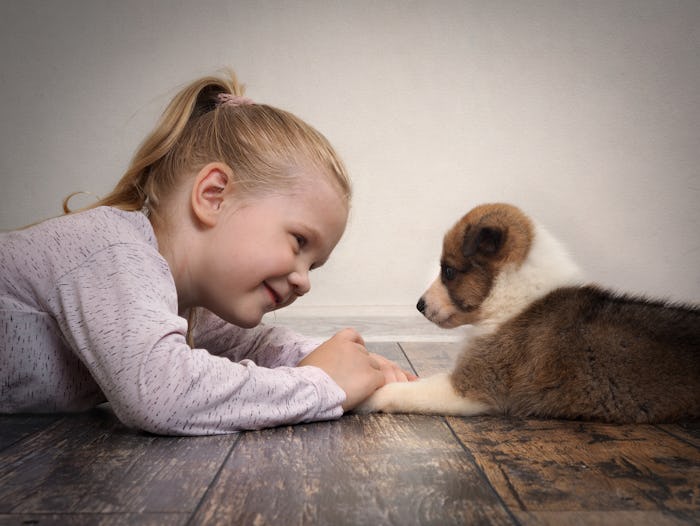Life
Yes, Even The Youngest Of Kids Can Help Train The Family Dog — Here's How
When a kid wants a dog, he'll likely make all kinds of promises about helping out with the new pet. All too often, unfortunately, those good intentions fade within weeks of your furry family member's arrival... and you end up picking the slack. But just because kids aren't great at being responsible 100 percent of the time doesn't mean they can't play a part in taking care of the family dog, even when they're little. In fact, kids can even help to teach your new pet. But how old does a kid have to be to train a dog?
When you're not even sure if you can trust your child to fill a water bowl without leaving a huge puddle on the floor, it might seem a bit unlikely, to say the least, that the same kid could be capable of successfully convincing a dog to listen to commands. But you might be surprised by how much your child can accomplish.
"Children of all ages can participate in dog training as long as the tasks are age-appropriate and there is adult supervision," Mary Burch, Ph.D., director of the Canine Good Citizen program at the American Kennel Club (AKC), told Parents.
Even kids as young as 4 or 5 can wrap their head around the concept of asking a dog to sit before giving him a treat, after all. And your kid's participation in the training process will help to "cement your dog's place in your family," as certified dog trainer Pat Miller, CPDT-KA, CBCC-KA, wrote in an article for Whole Dog Journal.
"Kids are great natural trainers, and tend to have more time than the adults do to spend with the dog," she explained.
Naturally, you'll be supervising and spearheading all training efforts — in other words, you'll need to train your kid how to train your dog. But there are still simple things that kids can do to effectively teach desired behaviors in dogs, and trusting your child with this task is an excellent way of making him feel like he's doing something important.
"Basic skills such as getting a dog to sit, stay down, come to you, and walk on a leash are easily taught with adult supervision," said Dr. Burch, who recommends using treats an an incentive to cooperate (for your dog, not your kid).
Miller also recommends using treats in the training process, as well as clickers or another type of "reward marker" (even the word "yes" will do). For example, your child should start out by showing your dog the desired behavior, such as sitting. When the dog finally sits, your kid should use the clicker (or say "yes!"), then give the dog a treat. The next step is getting your dog to associate sitting with the word "sit" by saying it just before he sits (then clicking and giving another treat). The goal is to get your dog to sit just by saying "sit" — without the lure of a treat.
"Finally, help him generalize the behavior to other locations, by taking your child and dog to practice at parks, on walks around the block, in parking lots, and in stores that allow dogs," said Miller.
"A good positive training class is another great place for your child to practice working with your dog around distractions."
Even if your kid doesn't turn into the next Cesar Millan, if he's consistent, his efforts could go a long way in helping to show your dog the ropes. Plus, the more of an investment he makes in the dog early on, the more bonded your dog and your child will be, and the more likely he'll be to help with all dog-related responsibilities in years to come. And you never know... dog training might even turn into a passion.
"Children as young as 7 years old train their dogs in 4-H classes, and in AKC competition, and juniors as young as 12 years old have succeeded in advanced obedience competition classes," said Dr. Burch.
Just be warned: Even the most dog-loving kid ever will still put up a fuss about picking up poop.
